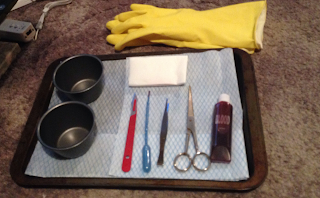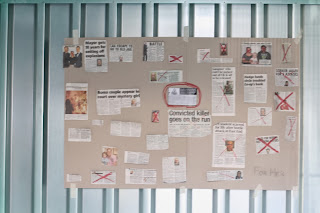Second
Case Study: Closed Doors
---
Written
and directed by James Button, 2011.
Synopsis:
Closed
Doors tells the story of a young man (early twenties) who over-hears banging
sounds from his neighbours’ flats and fears it might be domestic violence.
Having dealt with this with his own parents he decides to investigate upon
these strange occurrences. As he knocks on the door, a woman answers and tells
him nothing is wrong – although he doesn’t believe this. She closes the door
and the main character begins to walk back to his flat when he spots a drop of
blood from his shoe. He knocks back on the door and the same woman answers only
this time with a nose bleed, which leads him to believe she is being beaten up
by her partner. He questions her again and she still insists nothing is wrong.
The protagonist steps back and dials “999” when the woman’s partner opens the
door and questions him. Still believe some abuse is going on he invites the
woman to come with him to which her partner pushes him and tells him to leave
them alone and closes the door.
The
main character get angry and begins to have flashbacks of his abusive father.
He kicks the door open and begins a fight with the woman’s partner until
repeatedly hitting him with a bottle, the same way his father did in his
flashback. As the woman’s partner lies on the floor the main character calms
down and looks at his shoe where there is not a stain nor the woman has a nose
bleed, as he continues to look around the room he sees candles and roses
meaning there was no violence. He quickly leaves and returns his flat shaken up
by the events sits back down at his desk where he began and takes a creased
picture of himself and his mother.
The
narrative is disjointed as containing flashbacks presents a non-linear
timeline.
How are the
characters represented in “Closed Doors”?
Firstly
the male characters seem to have a role reversal with the good and bad
portrayal. However, the female character does not change as she is seen as the
damsel in distress and the one who suffers from the actions the male characters
do.
1) The protagonist: he is extremely shy throughout which is caused by
his childhood experience presented in his flashback. He is primarily shown as
the “hero” of the short piece which then reverses due to his misconception of
the accounts.
2) Second male
character: firstly he is
presented as the “villain” of the short piece as he is conceived to be the
troublemaker from the protagonist’s perspective. However, when the violent
actions of the main character are over he is presented as innocent.
3) Female
character: unlike the other two
characters she is seen as fragile and innocent throughout making her the
stereotypical woman who needs a man to protect her.
Use of Camera:
1)
Types of shots: wide shots, mid shots, close
ups and handheld.
2)
The wide shots are often used in order to
present suspense as the audience can look around the character’s surroundings
and know that something will happen but this is unknown throughout.
3)
Close ups lets the audience acknowledge
what the character is feeling and how the tension is built up by how the
character’s present their emotions.
4)
Handheld/shaky camera: this allows the audience to
realise that there is a disturbance within the storyline, there is a constant
relation to fear and tension.
Editing:
The
editing in “Closed Doors” helps to create a suspenseful feel to the short film.
This is done through the fast cutting rate between the shots as it shows that a
lot is going on during the scene. Another kind of editing techniques used in
this short film is shot-reverse-shot. This portrays the conversational scenes
although it also allows to capture the emotions of the characters and in this
case builds up tension.
Mise-en-Scene:
Location, lightning, costume, props and make-up:
1) Location: the location of this piece takes solely
within a block of flats.
2) Lightning: the lighting presented is quite dim in
order to augment the suspenseful tone that is typical to a horror film. The
darkness undertones in this short film the domestic violence which is a mere
hallucination for the protagonist.
3) Costumes: the costumes within this piece are not
very significant. This is because they have no major role in conveying meaning.
The characters are all dressed in a causal way which is normal. Although it
could be seen that the colour choices portray the emotions (anger) or even the
recurring symbol of blood by the colour red.
4) Props: There are a few props in this piece, such as
the cup which the protagonist uses to try to listen through the walls. The
bottle which he uses to beat the male character such as the way his father did
in his flashback. The final prop is the picture in the frame on his desk of
himself and his parents, though his father has been folded over which
metaphorically states that he isn’t part of his life no longer.
5) Make-up: only a small amount of make-up is used in
order to convey the violence thematic; the blood dripping from the female
character’s nose, for example.
Sound:
The sound usage is
extremely important, which is typical for a horror/thriller film. This is the
major feature that creates a successful feel of the short film. A number of
sound effects contribute to the suspense of the short film. These include;
echoes which make the scene feel big and empty, bass notes and flat line noises
that create tension, heartbeat effects which shows the feat of the characters.
And finally and potentially most important, silence which creates the bulk of
the suspense as it makes the audience think that something is about to happen.
Target Audience:
Personally, I feel
that the film would be targeted to a young audience of about 18-25 years old as
it contains strong language and violence. This short film would be perfect for
the mass audience which are keen to watching horror or thriller films as this
piece is within those genre boundaries.
What ideas could you use in your
own short film?
Within our film
production, we hope to create a piece with this similar genre, though we would
not take any ideas from the story but merely the function of sounds in order to
create suspense in our persecution scene. As well as the lighting and the
mise-en-scene. (Not the location)








































